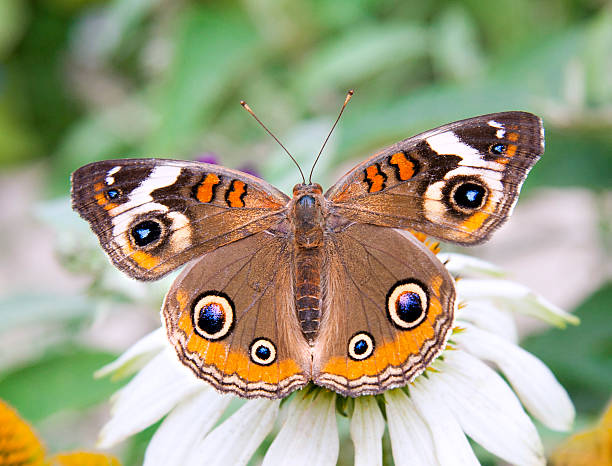ANIMAL: Common Buckeye Junonia coenia Type of Animal: Brush-Footed Butterfly Habitat: Fields, roadsides, open sunny utility corridors, open sunny gardens, flower gardens, open parks, open sunny yards, open sunny fallow agricultural land, pastures, open sunny scrub, scrub forest, open sunny weedlots, savanna, open areas, clearings, meadows, open coastal dunes, disturbed weedy areas, mud puddles, wooded edges, chaparral, wetlands w/ purple loosestrife Location(s): US E of Rocky Mountains, Canada E of Saskatchewan, Mexico, Bermuda, Bahamas, & Cuba. Overwinters in Florida, parts of Deep South, Cuba, Bermuda, Bahamas, & parts of Mexico. Most populations migratory moving to warmer areas starting in late summer through fall. Appearance: Adults mostly brown to tan-brown to reddish-brown w/ some orange/black/white/blue/magenta, forewings have 2 proximal orange bars & postmedian white band surrounding prominent black eyespot & bordering smaller more distal eyespot-both eyespots have bluish center w/ each bordering distal orange mark, blue-green overtones on front wings (sometimes on hindwings as well). Caterpillars black w/ white/gray/beige/brownish/mixed light color markings, white side markings, red-orange side spots, brown underside, & red-orange head w/ black face markings/2 small spines. Adult females larger w/ rounder forewings. Food/Diet: Adults eat nectar & fruit juice from Butterfly bush, hydrangea, zinnia, asters, lantanas, bidens, gumweeds, knapweeds, chicory, tickseed/coreopsis, dogbane, & peppermint as well as carrion. Caterpillars eat snapdragon, gerardia, false foxglove, monkeyflowers, plantain plants, ruellia, toadflax, cudweed, acanthus plants, vervains, speedwells, figworts, & snake herb. Status in Wild: Stable Conservation: Breeding in butterfly gardens, zoos, aquariums, & museums Lifestyle: Adults found in groups, though males territorial. Caterpillars solitary or in very small groups. Additional Info: Called: Male Female Young: Caterpillar Group: Flutter Gestation: 4-14 days Life Span: 1-5 months Body Length/Wingspan: Male: 1.77 in Female: 2.75 in Young: 1 in Main predators are birds, lizards, amphibians, wasps, ants, & spiders. Females lay eggs singly on/around host plants, w/ eggs hatching 4-14 days later. Caterpillar stage lasts 2-4 weeks, in which they go through 5 instars (development phases). After this, they transition to pupa (chrysalis) stage which lasts 1-2 weeks (can last a few months in resident populations). Then they transform into adult butterflies, which lasts 1-4 weeks. Males die after mating & females die after laying eggs. Like many butterflies, they’re important pollinators. Coloration aids in camouflage as well as deters predators. Fun Fact(s): Featured on 2006 USPS 24-cent postage stamp. Adults lack protection caterpillars have but can expel toxins in their waste at predators. Males often drink from sources that female often ignore, such as sand, mud, or dead animals. Brightly colored eyespots adaptation to deter predators. Caterpillars prefer plants rich in bitter-tasting chemical compounds called iridoid glycosides since caterpillars w/ higher concentrations of these compounds less preferable to predators.
